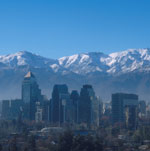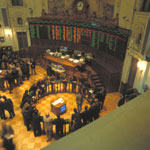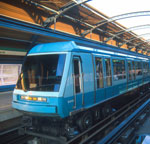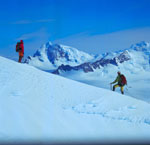Central
Zone
 |
Central
Chile is the cultural heart of the
country. The largest cities are
located in this area, as are most
of the universities and industries,
vineyards, the best farmland, and
examples of architecture from the
Colonial and Early Republic periods.
In a way, central Chile is a
microcosm of the country located
between the northern deserts and
the southern forests, with a capital
city nestled up against the highest
peaks in the Americas on one side
and with easy access to many excellent
beaches on the other.
The capital of Chile, Santiago,
is a focal point of the Latin
American economy. Most international
flights arrive here.
|
Clean and modern, with excellent hotels
and restaurants to satisfy the most discerning
palates, Santiago is located in the valley
between the Coastal mountain range to
the west and the Andes Mountains to the
east.
The ski slopes of the central Andes are
only 45 minutes away, up a series of hairpin
curves that climb 2200 meters (7200 ft)
in only 42 kilometers (26 miles). Many
vineyards, belonging to six different
wine-growing regions, are close to the
capital. Numerous hot springs, 17th century
haciendas, and national parks in the Andes
and coastal ranges can be easily visited
on day trips. At night, visitors can choose
among a wide variety of restaurants serving
regional or ethnic foods. Excellent hotels
guarantee a peaceful night's sleep for
the business traveler or tourist.
Towards
the west, modern highways connect
the capital city with the coastal
cities of Viña del Mar, Valparaíso,
and San Antonio. Like Santiago,
the central coast has a Mediterranean
climate, with short, mild winters
and sunny eight-month summers.
Here, stretches of white beaches
and coastal towns have something
for everyone, from luxurious vacation
resorts to isolated cabins, from
beach picnics to fresh seafood served
in open-air restaurants.
Toward the north,
the climate becomes drier. The beaches
and vacation spots stretch north
to La Serena, Chile's second-oldest
city and the de facto capital of
the pisco-producing region.
|
 |
 |
South of Santiago, the climate becomes colder and damper. These fertile lands
were the first to be claimed by
the Spanish conquistadors. Here
the Chilean huaso, or cowboy, still
lives all day in the saddle wearing
his traditional poncho and wide-brimmed
hat and perfecting his technique
for the annual rodeo.
Towards the east, the Andes Mountains
are an unforgettable sight, crowned
in white during winter and spring.
The spring thaw high up in the mountains
feeds the rivers that irrigate the
heart of Chile.
|
Beyond the first range of peaks,
visible from anywhere in the central
valley and from many places on the
coast, lies a labyrinth of canyons
carved out by glaciers, forests
with microclimates, alpine lakes,
and torrential rivers. Roads leading
into the mountains provide access
to numerous parks and unlimited
opportunities to enjoy skiing, hiking,
mountain climbing, mountain biking,
horseback riding, and rafting.
|
 |
|
|